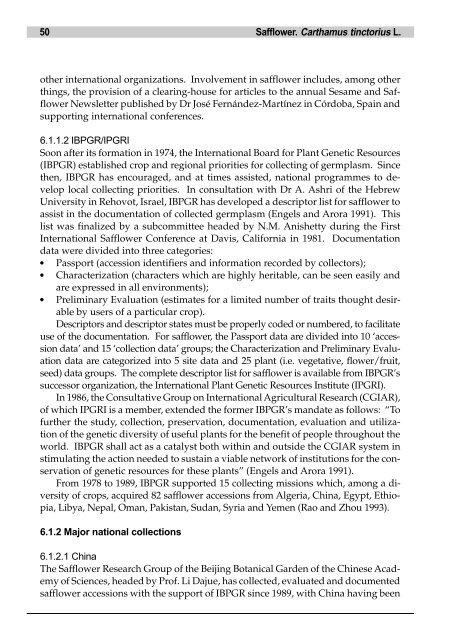Safflower, Carthamus tinctorius L. - Bioversity International
Safflower, Carthamus tinctorius L. - Bioversity International
Safflower, Carthamus tinctorius L. - Bioversity International
Create successful ePaper yourself
Turn your PDF publications into a flip-book with our unique Google optimized e-Paper software.
50 <strong>Safflower</strong>. <strong>Carthamus</strong> <strong>tinctorius</strong> L.<br />
other international organizations. Involvement in safflower includes, among other<br />
things, the provision of a clearing-house for articles to the annual Sesame and <strong>Safflower</strong><br />
Newsletter published by Dr José Fernández-Martínez in Córdoba, Spain and<br />
supporting international conferences.<br />
6.1.1.2 IBPGR/IPGRI<br />
Soon after its formation in 1974, the <strong>International</strong> Board for Plant Genetic Resources<br />
(IBPGR) established crop and regional priorities for collecting of germplasm. Since<br />
then, IBPGR has encouraged, and at times assisted, national programmes to develop<br />
local collecting priorities. In consultation with Dr A. Ashri of the Hebrew<br />
University in Rehovot, Israel, IBPGR has developed a descriptor list for safflower to<br />
assist in the documentation of collected germplasm (Engels and Arora 1991). This<br />
list was finalized by a subcommittee headed by N.M. Anishetty during the First<br />
<strong>International</strong> <strong>Safflower</strong> Conference at Davis, California in 1981. Documentation<br />
data were divided into three categories:<br />
● Passport (accession identifiers and information recorded by collectors);<br />
● Characterization (characters which are highly heritable, can be seen easily and<br />
are expressed in all environments);<br />
● Preliminary Evaluation (estimates for a limited number of traits thought desirable<br />
by users of a particular crop).<br />
Descriptors and descriptor states must be properly coded or numbered, to facilitate<br />
use of the documentation. For safflower, the Passport data are divided into 10 ‘accession<br />
data’ and 15 ‘collection data’ groups; the Characterization and Preliminary Evaluation<br />
data are categorized into 5 site data and 25 plant (i.e. vegetative, flower/fruit,<br />
seed) data groups. The complete descriptor list for safflower is available from IBPGR’s<br />
successor organization, the <strong>International</strong> Plant Genetic Resources Institute (IPGRI).<br />
In 1986, the Consultative Group on <strong>International</strong> Agricultural Research (CGIAR),<br />
of which IPGRI is a member, extended the former IBPGR’s mandate as follows: “To<br />
further the study, collection, preservation, documentation, evaluation and utilization<br />
of the genetic diversity of useful plants for the benefit of people throughout the<br />
world. IBPGR shall act as a catalyst both within and outside the CGIAR system in<br />
stimulating the action needed to sustain a viable network of institutions for the conservation<br />
of genetic resources for these plants” (Engels and Arora 1991).<br />
From 1978 to 1989, IBPGR supported 15 collecting missions which, among a diversity<br />
of crops, acquired 82 safflower accessions from Algeria, China, Egypt, Ethiopia,<br />
Libya, Nepal, Oman, Pakistan, Sudan, Syria and Yemen (Rao and Zhou 1993).<br />
6.1.2 Major national collections<br />
6.1.2.1 China<br />
The <strong>Safflower</strong> Research Group of the Beijing Botanical Garden of the Chinese Academy<br />
of Sciences, headed by Prof. Li Dajue, has collected, evaluated and documented<br />
safflower accessions with the support of IBPGR since 1989, with China having been

















